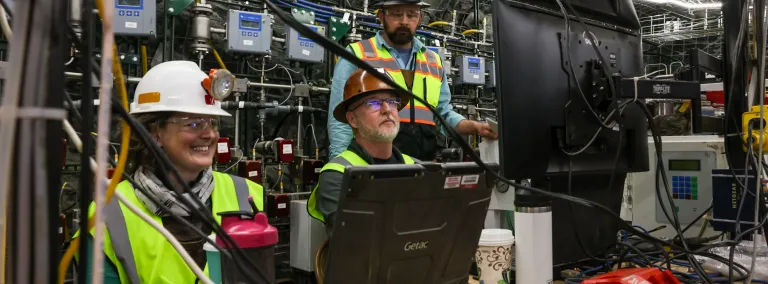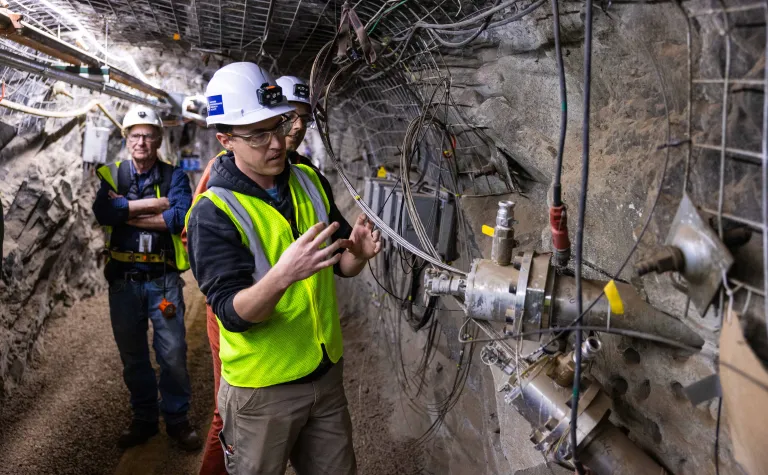Geothermal research at SURF takes leap forward with DOE Energy Earthshots initiative
SURF is home to the next generation of geothermal energy research through the DOE Energy Earthshots initiative
The Sanford Underground Research Facility (SURF) will be home to the next generation of geothermal energy research through Department of Energy (DOE) funding for the Energy Earthshots Initiative. According to the DOE, Energy Earthshots™ are the frontiers of the clean energy transition that will accelerate breakthroughs of more abundant, affordable, and reliable clean energy solutions within the decade.
The Energy Earthshots geothermal research at SURF is advancing development of new systems that can harness the earth’s natural heat, stored in deep rock layers, for electricity generation. These Enhanced Geothermal Systems (EGS) could enable clean energy generation at large-scale geothermal powerplants around the world.
The initiative at SURF includes the Center for Understanding Subsurface Signals and Permeability (CUSSP) experiment led by Pacific Northwest National Laboratory. This experiment will help scientists better understand how fluids transfer heat and interact with deep underground rock fractures over the long term.
“We’re thrilled about DOE’s recent funding announcement for the Center for Understanding Subsurface Signals and Permeability experiment,” said Dr. Jaret Heise, science director at SURF. “This new project will continue to leverage significant investments by the DOE in geothermal infrastructure at SURF. Not only that, but the CUSSP project in combination with current and previous efforts will take us through more than a decade of geothermal science at SURF.”
For next generation geothermal power plants to become reality, scientists need to study how hot fluids flow through rock fractures over time. Extreme conditions deep underground mean that a fracture network can change over time in complex ways that are difficult to predict.
One challenge is understanding how to keep a geothermal system working for many years without clogging up; think of old pipes inside a home that can become clogged or corroded over time by minerals in the water.
“Our approach will use sensing measurements from an active field site to find clear links between the detected signals and different physical and chemical processes that control fluid flow,” said Dr. Kevin Rosso, the principal investigator for the CUSSP experiment. “This would allow us to learn and ultimately predict what’s happening both now—and in the future—based on data from a realistic test site.” Rosso is a laboratory fellow and the associate director of the Physical Sciences Division for Geochemistry at Pacific Northwest National Laboratory (PNNL).
SURF has a long history of cutting-edge geothermal research starting in 2017 with the permeability and Induced Seismicity Management for Energy Technologies (kISMET), project on the 4850 level. The Enhanced Geothermal Systems (EGS) Collab began with sites on the 4850 level and ultimately created a long-term test bed on the 4100 level in 2021.
“We are very happy to garner interest from the DOE’s Energy Earthshots Initiative and to play a role in developing our nation’s energy independence with CUSSP. We are also grateful for the hard work of previous groups of scientists at SURF who opened the door to this new era of energy research here at America’s deep underground laboratory,” says Heise.
The research taking place deep underground at SURF could revolutionize clean energy generation on the planet. According to the DOE, investments in EGS can unlock affordable clean energy for over 65 million American homes and exponentially increase opportunities for geothermal heating and cooling solutions nationwide.
“Our Energy Earthshots are game-changing endeavors to unleash the technologies of the clean energy transition and make them accessible, affordable, and abundant,” U.S. Secretary of Energy Jennifer M. Granholm said in a DOE press release.


